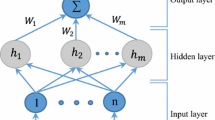Abstract
Radial basis function network (RBFN) is used in this paper for predefined trajectory control of both one-link and two-link robotic manipulators. The updating equations for the RBFN parameters were derived using the gradient descent principle. The other advantage of using this principle is that it shows the clustering effect in distributing the radial centres. To increase the complexity, the dynamics of robotic manipulator is assumed to be unknown, and hence, simultaneous control and identification steps were performed using the RBFNs. The performance of the RBFN is compared with the multilayer feed-forward neural network (MLFFNN) in terms of mean square error, tolerance to disturbance and parameter variations in the system. The efficacy of RBFN as a controller and identification tool is verified by performing the simulation study, and the results obtained reveal the superior performance of RBFN over MLFFNN in both identification and control aspects for one-link and two-link robotic manipulators.










































Similar content being viewed by others
References
Ayala HVH, dos Santos Coelho L (2012) Tuning of pid controller based on a multiobjective genetic algorithm applied to a robotic manipulator. Expert Syst Appl 39(10):8968–8974
Behera L, Kar I (2010) Intelligent systems and control principles and applications. Oxford University Press, Oxford
Chen L, Wu R, He Y, Chai Y (2015) Adaptive sliding-mode control for fractional-order uncertain linear systems with nonlinear disturbances. Nonlinear Dyn 80(1–2):51–58
Choi YH, Yoo SJ (2016) Single-approximation-based adaptive control of a class of nonlinear time-delay systems. Neural Comput Appl 27(4):1041–1052
Corradini ML, Giantomassi A, Ippoliti G, Longhi S, Orlando G (2015) Robust control of robot arms via quasi sliding modes and neural networks. In: Advances and applications in sliding mode control systems. Springer, pp 79–105
Gao H, Liu J, Li Y, Hong K, Zhang Y (2015) Dual-layer fuzzy control architecture for the cas rover arm. Int J Control Autom Syst 13(5):1262–1271
Gundogdu O, Egrioglu E, Aladag CH, Yolcu U (2016) Multiplicative neuron model artificial neural network based on gaussian activation function. Neural Comput Appl 27(4):927–935
Haykin S, Network N (2004) A comprehensive foundation. Neural Netw 2:2004
He W, Ge SS, Li Y, Chew E, Ng YS (2015) Neural network control of a rehabilitation robot by state and output feedback. J Intell Robot Syst 80(1):15–31
Huang SJ, Lee JS (2000) A stable self-organizing fuzzy controller for robotic motion control. IEEE Trans Ind Electron 47(2):421–428
Kondaiah V, Rao JS, Rao VS (2016) Parameter estimation of solid cylindrical electromagnetic actuator using radial basis function neural networks. In: Microelectronics, electromagnetics and telecommunications. Springer, pp 349–363
Lazzaretti AE, Tax DM (2015) An adaptive radial basis function kernel for support vector data description. In: Similarity-based pattern recognition. Springer, pp 103–116
Li Y, Ho YK, Chua CS (2000) Model-based pid control of constrained robot in a dynamic environment with uncertainty. In: Proceedings of the 2000 IEEE international conference on control applications, 2000. IEEE, pp 74–79
Lochan K, Roy B (2015) Control of two-link 2-dof robot manipulator using fuzzy logic techniques: a review. In: Proceedings of fourth international conference on soft computing for problem solving. Springer, pp 499–511
Mitra S, Basak J (2001) Frbf: a fuzzy radial basis function network. Neural Comput Appl 10(3):244–252
Narendra KS, Parthasarathy K (1990) Identification and control of dynamical systems using neural networks. IEEE Trans Neural Netw 1(1):4–27
Paul RP (1981) Robot manipulators: mathematics, programming, and control: the computer control of robot manipulators. Richard Paul
Sanxiu W, Shengtao J (2011) Adaptive friction compensation of robot manipulator. In: Electronics and signal processing. Springer, pp 127–134
Sciavicco L, Siciliano B (2012) Modelling and control of robot manipulators. Springer, New York
Singh M, Srivastava S, Gupta J, Handmandlu M (2007) Identification and control of a nonlinear system using neural networks by extracting the system dynamics. IETE J Res 53(1):43–50
Srivastava S, Singh M, Hanmandlu M (2002) Control and identification of non-linear systems affected by noise using wavelet network. In: Computational intelligence and applications. Dynamic Publishers, pp 51–56
Srivastava S, Singh M, Hanmandlu M, Jha AN (2005) New fuzzy wavelet neural networks for system identification and control. Appl Soft Comput 6(1):1–17
Srivastava S, Singh M, Madasu VK, Hanmandlu M (2008) Choquet fuzzy integral based modeling of nonlinear system. Appl Soft Comput 8(2):839–848
Stephanopoulos G (1984) Chemical process control: an introduction to theory and practice
Sun D, Mills JK (1999) High-accuracy trajectory tracking of industrial robot manipulator using adaptive-learning scheme. In: American control conference, 1999. Proceedings of the 1999, vol 3, IEEE, pp 1935–1939
Tran MD, Kang HJ (2015) Adaptive fuzzy pid sliding mode controller of uncertain robotic manipulator. In: Intelligent computing theories and methodologies. Springer, pp 92–103
Várkonyi-Kóczy A, Tusor B, Bukor J (2016) Data classification based on fuzzy-rbf networks. In: Soft computing applications. Springer, pp 829–840
Wu XJ, Jiang GC, Wang XJ, Fang N, Zhao L, Ma YM, Luo SJ (2013) Prediction of reservoir sensitivity using rbf neural network with trainable radial basis function. Neural Comput Appl 22(5):947–953
Funding
This study is not funded by any agency.
Author information
Authors and Affiliations
Corresponding author
Ethics declarations
Conflict of interest
Rajesh Kumar declares that he has no conflict of interest. Smriti Srivastava declares that she has no conflict of interest. J.R.P. Gupta declares that he has no conflict of interest.
Ethical approval
This article does not contain any studies with human participants or animals performed by any of the authors.
Rights and permissions
About this article
Cite this article
Kumar, R., Srivastava, S. & Gupta, J.R.P. Online modeling and adaptive control of robotic manipulators using Gaussian radial basis function networks. Neural Comput & Applic 30, 223–239 (2018). https://doi.org/10.1007/s00521-016-2695-8
Received:
Accepted:
Published:
Issue Date:
DOI: https://doi.org/10.1007/s00521-016-2695-8




